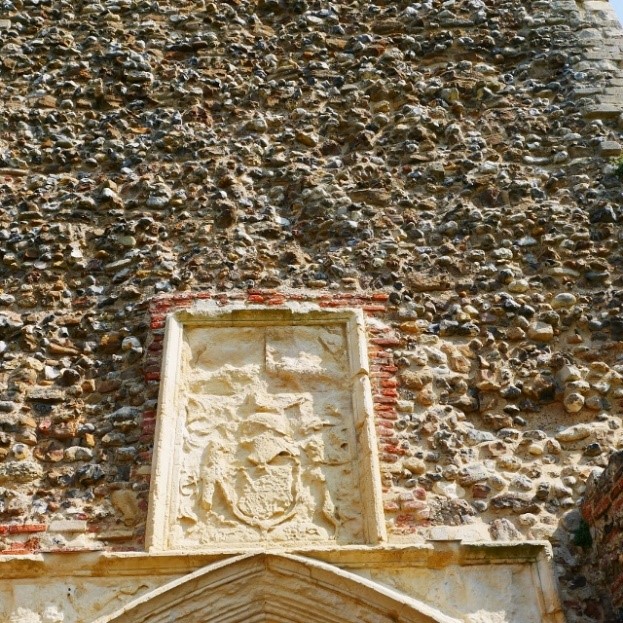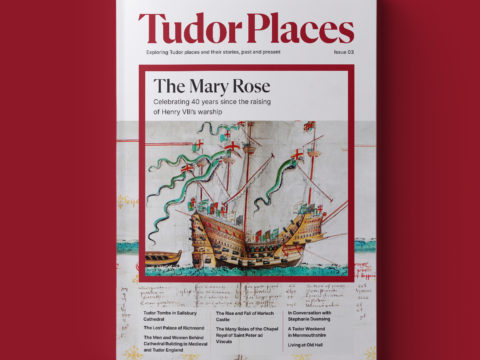Framlingham Castle
A stunning fortress in delightful countryside
Chapter 4 : The Howards
John Howard thus became 1st Duke of Norfolk in the Howard creation. His descendants still retain the title. (Read more on the Howards here). John expended considerable amounts on Framlingham, modernising the interior. It is his arms which are just visible above the gatehouse.
John Howard was killed at Bosworth, fighting for Richard III. His son, Thomas, who also fought for Richard, was briefly imprisoned, but then found favour under Henry VII. Thomas had had his title of Earl of Surrey re-conferred in 1489, but Henry VII was reluctant to confer dukedoms, other than on his immediate family. Thomas’ stunning victory at the Battle of Flodden in 1513, which resulted in the death of James IV of Scotland, was the occasion for Henry VIII to regrant the dukedom.

As 2nd Duke of Norfolk, Thomas was one of the last great mediaeval magnates and his sumptuous funeral in 1524 was a fabulous example of the pageantry of pre-Reformation death rites. He died at Framlingham, which had become his favourite home. He lay in state in the castle chapel for four weeks (in summer!) before being transported to the family mausoleum, thirty miles away at Thetford Priory. The procession took two days to arrive and included the Duke’s household, and members of his wider affinity, all garbed in black, and carrying torches. His tomb was surrounded by 100 wax effigies and 700 candles. After the distribution of alms, 1,900 guests were dined and entertained.
All of this ritual was arranged by his son, Thomas, now 3rd Duke of Norfolk. This Thomas was an important member of Henry VIII’s government. He had married Anne, the sister of Queen Elizabeth of York, but unfortunately, all of their children died young. His second wife was the daughter of the Duke of Buckingham, by whom he had Henry and Mary. Thomas held the post of Lord Lieutenant of Ireland, and was Henry’s chief military advisor and a member of the Privy Council.
Framlingham was rather old fashioned by the time of the 3rd Duke, who moved his main residence to Kenninghall, in Norfolk. Amongst Thomas’ numerous kin (his father had married twice and had twenty-two children) were Anne Boleyn and Katheryn Howard, the second and fifth wives of Henry VIII. To have a niece as queen was a great coup for the Howard duke, but the shine rather wore off when both queens were executed for adultery. He also had the distinction of being father-in-law to Henry FitzRoy, the king’s illegitimate son.
The Duke managed to avoid being overthrown completely by the disgrace of his nieces – in the first instance by his solid service during the Pilgrimage of Grace in 1536, and in the second by disclaiming all responsibility for poor Katheryn. Nevertheless, he was no longer part of the king’s inner circle, and the foolish pride of his son, the talented poet Henry Howard, Earl of Surrey, brought down doom on the Howards.
The Earl of Surrey was executed for treason, and Duke Thomas was also lined up for the axe when Henry VIII died. Nevertheless, the Howard estates, including Framlingham and Kenninghall, were confiscated and became crown property.
In early 1547, much of the Howard inheritance was granted to the Lady Mary, daughter of Henry VIII, and half-sister of the new king, Edward VI. Mary made extensive use of them, building her power as a magnate in East Anglia, and spending much of her time at Kenninghall.
In early July 1553, Mary was summoned to London, to see her half-brother, who was gravely ill. The princess set out, but was warned that the summons was a trap. Edward was already dead, and there was a scheme afoot (set in motion by the king) to prevent Mary inheriting the throne, as was her right under the Act of Succession of 1544 and Henry VIII’s will.
Mary spun round and galloped at full speed for Kenninghall, and then Framlingham. The castle was the most easily defensible of all her estates, and was also within 12 miles of the coast, should she need to escape to Europe. Not that Mary had any intention of fleeing. She set up her royal standard, and demanded to be recognised as Queen by the Privy Council. Soon, Framlingham was crowded with men and weapons, from all classes of society. They mustered at the castle, and Mary rode out on a white horse to inspect her troops. Despite her excellent horsemanship, her mount, not trained for battle, reared and almost threw her, so she walked up and down the ranks.
By the 19th July, she had been proclaimed Queen in London, and left Framlingham for the last time. On arrival in London, she found 80 year old Duke Thomas, who had been in the Tower since 1546. She released him, and restored the Howard patrimony, including Framlingham. In 1554, the inheritance passed to the old duke’s grandson, who became 4th Duke of Norfolk.
This Duke, too, became involved in politics to his detriment. Second cousin to Elizabeth I, and a conforming Protestant, he became embroiled in a plot to marry Mary, Queen of Scots. Whilst his motives were probably genuinely to neuter the danger to Elizabeth of an alternative, Catholic monarch, whom many believed to be the legitimate queen, Norfolk was unable to disentangle himself from accusations of treason, and was executed in 1572. Framlingham once again became Crown land.
The buildings inside the castle walls were deteriorating badly, but the castle was still sufficiently strong to be used to house some 40 prisoners – Catholic priests and local recusants, some of whom were hanged, drawn and quartered.






